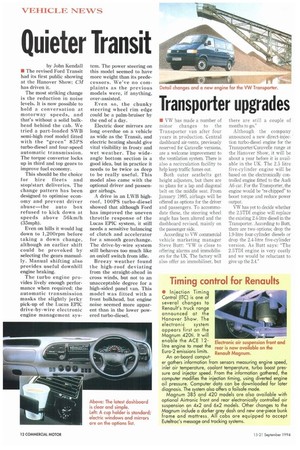Quieter Transit
Page 14

If you've noticed an error in this article please click here to report it so we can fix it.
by John Kendall • The revised Ford Transit had its first public showing at the Hanover Show; CM has driven it.
The most striking change is the reduction in noise levels. It is now possible to hold a conversation at motorway speeds, and that's without a solid bulkhead behind the cab. We tried a part-loaded SWB semi-high roof model fitted with the "green" 85PS turbo-diesel and four-speed automatic transmission. The torque convertor locks up in third and top gears to improve fuel economy.
This should be the choice for hire fleets and stop/start deliveries. The change pattern has been designed to optimise economy and prevent driver abuse—the auto box refused to kick down at speeds above 56km/h (35mph).
Even on hills it would lug down to 1,200rpm before taking a down change, although an earlier shift could be provoked by selecting the gears manually. Manual shifting also provides useful downhill engine braking.
The turbo engine provides lively enough performance when required; the automatic transmission masks the slightly jerky pick-up of the Lucas EPIC drive-by-wire electronic engine management sys tern. The power steering on this model seemed to have more weight than its predecessors. We've no complaints as the previous models were, if anything, over-assisted.
Even so, the chunky steering wheel rim edge could be a palm-bruiser by the end of a day.
Electric door mirrors are long overdue on a vehicle as wide as the Transit, and electric heating should give vital visibility in frosty and wet weather. The wide angle bottom section is a good idea, but in practice it needs to be twice as deep to be really useful. This model also came with the optional driver and passenger airbags.
A drive in an LWB highroof, 100PS turbo-diesel showed that although Ford has improved the uneven throttle response of the Lucas EPIC system, it still needs a sensitive balancing of clutch and accelerator for a smooth gearchange. The drive-by-wire system still behaves too much like an on/off switch from idle.
Breezy weather found the high-roof deviating from the straight-ahead in cross winds, but not to an unacceptable degree for a high-sided panel van. This model was fitted with a front bulkhead, but engine noise seemed more apparent than in the lower powered turbo-diesel.
































































































